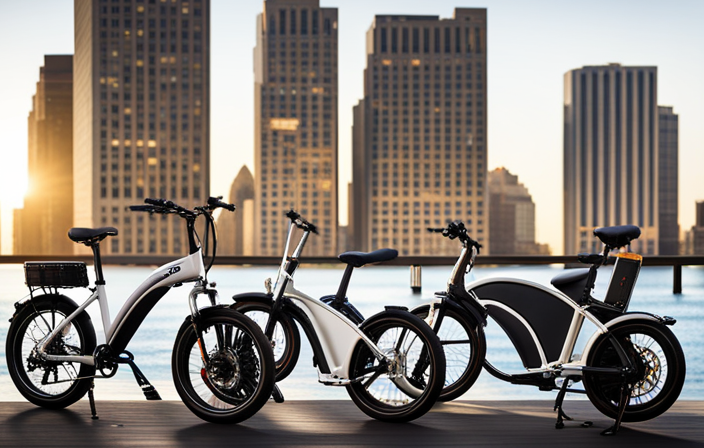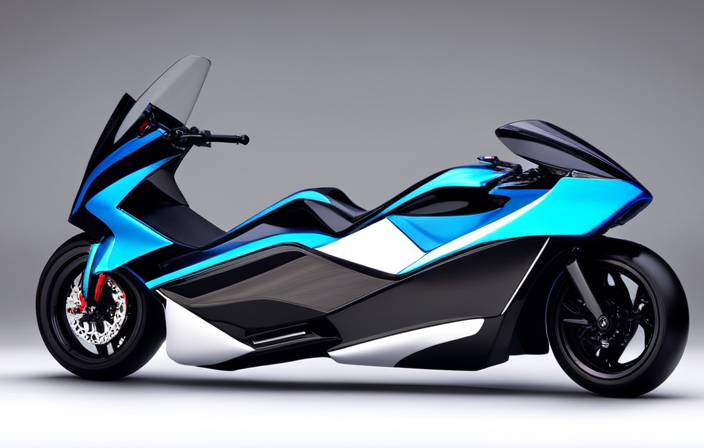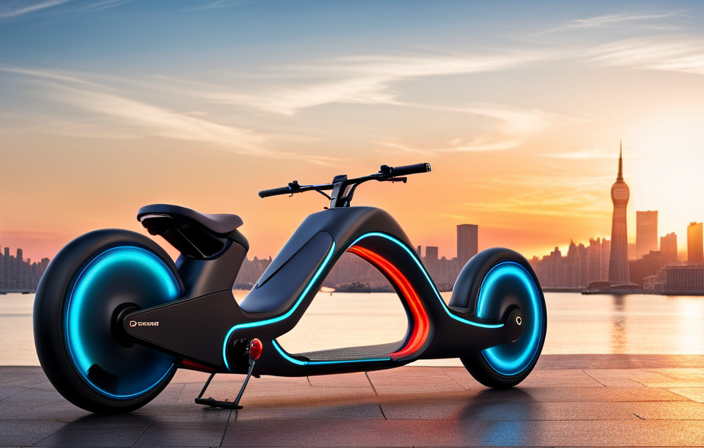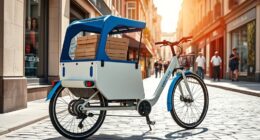As an avid cyclist, I’ve always been intrigued by the idea of upgrading my bike to an electric one. But with so many options out there, it’s hard to know which wattage is best.
That’s why I’ve decided to dive deep into the world of electric bike kits and explore the factors that need to be considered when choosing wattage.
Join me on this informative journey as we uncover the benefits, installation tips, and safety precautions of upgrading to an electric bike with the perfect wattage for your needs.
Key Takeaways
- Higher wattage kits provide more power and speed, but they are also more expensive.
- Wattage should be chosen based on specific needs and preferences, as well as factors like terrain, riding conditions, and rider’s weight and fitness level.
- Low wattage options (250W-350W) are affordable and lightweight, suitable for budget-conscious buyers.
- High wattage options (750W and above) offer maximum power and speed, making them suitable for challenging terrains and riders with higher fitness levels.
Understanding Electric Bike Kits
If you’re new to electric bike kits, understanding the different wattages is essential. When it comes to electric bike kits, the wattage refers to the power output of the motor. Higher wattages generally mean more power and speed. However, it’s important to consider your specific needs and preferences before deciding on a wattage for your electric bike kit.
One factor to consider is the cost. Higher wattage electric bike kits tend to be more expensive compared to lower wattage options. This is because higher wattage motors require more advanced components and technology to handle the increased power output. So, if you’re on a budget, you may want to opt for a lower wattage electric bike kit to save on costs.
Another factor to consider is the components of the electric bike kit. Higher wattage kits often come with more robust components, such as larger batteries and stronger motors. These components are designed to handle the increased power output and provide a smoother and more efficient riding experience. However, if you don’t require high speeds or have specific weight limitations, a lower wattage kit may still be suitable for your needs.
Understanding the different wattages of electric bike kits is crucial in making an informed decision. By considering factors such as cost and components, you can choose the right wattage for your electric bike kit that aligns with your needs and preferences.
Now, let’s explore the benefits of upgrading to an electric bike and how it can enhance your riding experience.
Benefits of Upgrading to an Electric Bike
Upgrading to an e-bike offers numerous advantages, such as increased speed and reduced effort while riding. When you choose to upgrade your standard bike to an electric one, you open up a whole new world of possibilities. Here are some of the benefits you can expect:
-
Enhanced Speed:
With an electric motor, you can effortlessly reach higher speeds, making your commutes or leisure rides faster and more efficient. The added speed allows you to cover longer distances in less time, expanding your cycling range. -
Reduced Effort:
Riding uphill or against strong headwinds can be physically demanding, but with an e-bike, the motor provides assistance, making these challenges much easier to conquer. With reduced effort, you can enjoy longer rides or even tackle hilly terrains that were previously daunting.
These are just a few of the many advantages that come with upgrading to an electric bike. However, when considering which e-bike kit to choose, wattage is a crucial factor. Understanding the wattage factors will help you make an informed decision and find the perfect balance between power and efficiency.
Factors to Consider When Choosing Wattage
When choosing the wattage for your electric bike, it’s important to consider a few key factors.
First, take into account the terrain and riding conditions you’ll be encountering. If you’ll be tackling steep hills or rough off-road trails, a higher wattage motor may be necessary for optimal performance.
Second, consider your own weight and fitness level. If you’re on the heavier side or not in the best shape, a higher wattage motor can help provide the extra power needed to assist you on your rides.
Terrain and Riding Conditions
For your electric bike kit, consider the wattage that would be most suitable for your terrain and riding conditions. The wattage of your electric bike motor determines its power and performance. When choosing the wattage, keep in mind the challenges you may face while riding uphill and the off-road capabilities you desire.
Here are a few factors to consider:
-
Uphill challenges: A higher wattage motor will provide more power to conquer steep inclines with ease.
-
Off-road capabilities: If you plan on taking your electric bike off-road, opt for a higher wattage to handle rough terrains and uneven surfaces.
Consider these factors carefully to ensure that your electric bike kit provides the necessary power for your specific needs.
Now, let’s move on to discussing the impact of the rider’s weight and fitness level.
Rider’s Weight and Fitness Level
To maximize your riding experience, it is important to consider how your weight and fitness level will impact the performance of the electric bike.
Your weight plays a crucial role in determining how the bike performs. A heavier rider will require a more powerful motor and battery to ensure optimal performance. If the bike is not equipped to handle the rider’s weight, its speed and acceleration may be affected.
Similarly, your fitness level will also impact the bike’s performance. If you are in good shape and can pedal efficiently, you may not need as much assistance from the motor. However, if you have lower fitness levels, you might require a more powerful motor to assist you during your rides.
Understanding your weight and fitness level will help you choose the right electric bike kit for your needs.
Now, let’s discuss how desired speed and range factor into the equation.
Desired Speed and Range
If you want to go faster and cover more distance, you should consider your desired speed and range when choosing an electric bike. The desired speed refers to how fast you want to go, while the range refers to the distance you want to travel before recharging the battery.
Here are a few things to consider:
-
Desired Speed:
-
Determine whether you want a bike that can reach higher speeds or if a moderate speed is sufficient for your needs.
-
Consider the type of terrain you will be riding on, as some bikes are better suited for hilly areas.
-
Take into account any local regulations or speed limits that may apply to electric bikes.
-
Battery Life:
-
Look for a bike with a battery that can provide the desired range you need for your rides.
-
Consider factors such as your weight, the terrain, and whether you will be using pedal assist or throttle mode, as these can affect the battery life.
-
Keep in mind that battery life can vary depending on the speed at which you are riding.
Considering these factors will help you choose an electric bike that meets your desired speed and range requirements.
Now let’s explore the next section on low wattage options (250w-350w).
Low Wattage Options (250W-350W)
The low wattage options, ranging from 250W to 350W, are worth considering for those seeking a more affordable and lightweight electric bike kit. These kits have their own set of pros and cons compared to higher wattage options.
One of the advantages of low wattage electric bike kits is their affordability. They tend to be cheaper than higher wattage kits, making them a great option for those on a budget. Additionally, the lower wattage means a lighter weight, which can make a significant difference when it comes to maneuverability and ease of use.
However, there are also some drawbacks to low wattage electric bike kits. The main disadvantage is their limited power output. With lower wattage, you won’t get the same level of speed and acceleration as you would with higher wattage kits. This can be a disadvantage if you’re looking for a fast and powerful ride. Additionally, low wattage kits may not be suitable for hilly terrains or for riders who are on the heavier side.
When comparing low wattage kits to high wattage kits, it’s important to consider your specific needs and preferences. If you prioritize affordability and lightweight design, then a low wattage kit could be a good choice for you. However, if you need more power and speed, especially for challenging terrains, then you might want to consider looking into mid wattage options (350W-500W). These kits offer a balance between power and affordability, providing a great compromise for many riders.
Mid Wattage Options (350W-500W)
When considering your options, you might find that mid wattage kits in the range of 350W to 500W offer a good balance between power and affordability. These mid wattage options have their own unique benefits and limitations that are important to consider before making a decision.
Benefits of mid wattage kits:
- Enhanced power: Mid wattage kits provide a significant boost in power compared to low wattage options. This allows for faster acceleration and easier climbing on various terrains.
- Extended range: With a mid wattage kit, you can expect a longer range compared to low wattage options. This means you can go on longer rides without worrying about running out of battery power.
- Versatility: Mid wattage kits are suitable for a wide range of riders and riding styles. Whether you’re commuting to work or going on off-road adventures, a mid wattage kit can handle it all.
Limitations of mid wattage kits:
- Reduced efficiency: While mid wattage kits offer more power, they can also consume more energy. This can lead to a shorter battery life and more frequent recharges.
- Limited top speed: Mid wattage kits may not be able to achieve the same high speeds as their high wattage counterparts. If speed is a priority for you, you may want to consider a higher wattage option.
In comparison to low wattage options, mid wattage kits provide a noticeable increase in power and range. However, if you’re looking for even more power and performance, it’s time to explore the high wattage options (500W and above).
High Wattage Options (500W and above)
For riders seeking more power and performance, it’s time to explore the high wattage options available (500W and above).
Upgrading power on your electric bike can open up a whole new world of possibilities. With a higher wattage motor, you can conquer challenging terrains, tackle steep hills with ease, and enjoy a faster, more exhilarating ride.
When it comes to motor options for high wattage kits, there are a few key factors to consider.
Firstly, you’ll want to make sure that your bike frame can handle the increased power. Some frames may not be compatible with high wattage motors, so it’s important to do your research and consult with a knowledgeable bike shop or electric bike expert.
Additionally, you’ll need to ensure that you have a suitable battery to support the increased power output. High wattage motors require more energy, so investing in a higher capacity battery is essential.
Finally, it’s crucial to consider the legal considerations for high wattage kits. While high wattage motors can offer an incredible boost in power and performance, they may not comply with local regulations. It’s important to familiarize yourself with the legal restrictions and requirements in your area to ensure that you are riding within the limits.
Legal Considerations for High Wattage Kits
After exploring the high wattage options for electric bike kits, it is important to consider the legal implications and insurance requirements associated with these powerful kits.
As an avid electric bike enthusiast, I have learned that riding a high wattage electric bike kit may have legal restrictions depending on your location. In some areas, there are specific rules and regulations that dictate the maximum wattage allowed for electric bikes to be considered legal on public roads. It is crucial to familiarize yourself with these laws to ensure compliance and avoid any legal consequences.
Additionally, insurance requirements should not be overlooked when it comes to high wattage electric bike kits. Some insurance policies may have limitations or exclusions for electric bikes that exceed a certain wattage threshold. Before purchasing a high wattage kit, it is advisable to contact your insurance provider and inquire about their coverage for electric bikes. This will help you understand if any additional coverage or modifications are needed to ensure adequate protection.
Understanding the legal implications and insurance requirements associated with high wattage electric bike kits is essential for a safe and compliant riding experience.
Now that we have explored these factors, let’s delve into the next section about battery capacity and range, which plays a vital role in determining the performance and distance capabilities of electric bikes.
Battery Capacity and Range
Understanding the maximum battery capacity and range is crucial for determining the performance and distance abilities of high wattage electric bike kits. The battery life of an electric bike kit refers to how long the battery can power the motor before needing to be recharged. This is an important factor to consider, as it directly impacts how far you can ride on a single charge. Charging time, on the other hand, refers to the amount of time it takes to fully charge the battery after it has been depleted.
To help visualize the importance of battery capacity and range, let’s take a look at the following table:
| Electric Bike Kit | Maximum Battery Capacity | Range |
|---|---|---|
| Kit A | 500Wh | 50 miles |
| Kit B | 750Wh | 75 miles |
| Kit C | 1000Wh | 100 miles |
As you can see, the higher the battery capacity, the longer the range. This means that a kit with a 1000Wh battery will allow you to ride up to 100 miles on a single charge, while a kit with a 500Wh battery will only take you 50 miles. Additionally, it’s important to consider the charging time of the battery. Some batteries may take longer to charge, which can affect your overall riding experience.
Considering battery life and charging time are just a few of the factors to consider when choosing a high wattage electric bike kit. Next, we will discuss other important factors to keep in mind.
Other Factors to Consider
When choosing the right high wattage electric bike kit, it’s important to consider factors such as weight, motor type, and available assist levels. These factors can greatly impact your overall experience and satisfaction with the kit.
Here are three important factors to consider:
-
Weight: A heavier electric bike kit may affect the overall maneuverability and handling of your bike. It’s important to choose a kit that suits your bike’s weight capacity and your own physical capabilities.
-
Motor Type: Different electric bike kits come with different motor types, such as hub motors or mid-drive motors. Each type has its own advantages and disadvantages, so it’s important to choose one that aligns with your specific needs and preferences.
-
Available Assist Levels: The available assist levels determine the amount of power assistance provided by the electric bike kit. Some kits offer multiple assist levels, allowing you to choose the level of assistance that best suits your riding style and terrain.
Considering these factors will help you make an informed decision when selecting a high wattage electric bike kit. However, it’s also important to consider other aspects such as cost considerations and environmental impact.
Now let’s move on to the next section, where we will explore testimonials and reviews from electric bike kit users.
Testimonials and Reviews from Electric Bike Kit Users
Before we delve into the recommended electric bike kit wattages for different scenarios, it’s important to consider the experiences of riders who have already tried various electric bike kits. Testimonials from experienced riders can provide valuable insights into the performance and reliability of different brands.
When researching electric bike kits, I came across numerous testimonials and reviews from riders who have tried out different brands. These testimonials allowed me to compare the experiences of riders and gain a better understanding of what to expect from each brand.
One rider, for example, praised Brand X for its powerful motor and long-lasting battery life, making it perfect for long-distance commuting. Another rider favored Brand Y for its compact design and ease of installation, making it ideal for riders who frequently switch between their electric and regular bikes.
By comparing these testimonials and reviews, I was able to gain a comprehensive understanding of the strengths and weaknesses of different electric bike kit brands. This knowledge allowed me to make an informed decision when choosing the right wattage for my electric bike kit.
Now that we have explored the testimonials and reviews from experienced riders, let’s dive into the recommended electric bike kit wattages for different scenarios.
Recommended Electric Bike Kit Wattages for Different Scenarios
To determine the most suitable wattage for your electric bike kit, you should consider factors such as the terrain you’ll be riding on and your desired speed. For commuting purposes, a lower wattage between 250-500 watts would be sufficient. This wattage range provides enough power to assist you in reaching your destination without excessive strain on the battery. It is also ideal for maintaining a moderate speed for urban commutes.
On the other hand, if you enjoy off-road trails and require more power to tackle steep inclines and rough terrains, a higher wattage between 750-1000 watts would be more suitable. This increased wattage allows for better torque and acceleration, enabling you to conquer challenging trails with ease.
Keep in mind that higher wattage also means greater energy consumption and a shorter battery life. Therefore, it’s essential to consider the distance you’ll be traveling and the availability of charging stations along the way.
In conclusion, the wattage of your electric bike kit should be chosen based on your specific needs and preferences. Whether you’re commuting or exploring off-road trails, selecting the appropriate wattage will ensure an optimal riding experience.
Now that you have determined the best wattage for your electric bike kit, let’s move on to installation and maintenance tips for keeping your bike in top-notch condition.
Installation and Maintenance Tips
Now that you know the appropriate wattage for your electric bike kit, let’s discuss some installation and maintenance tips to keep your bike in excellent condition.
When it comes to installation techniques, it’s important to carefully follow the instructions provided with your kit. Start by removing your bike’s front wheel and attaching the motor wheel in its place. Secure it tightly using the provided bolts and washers. Next, connect the motor controller to the battery, ensuring that all the connections are tight and secure. Finally, mount the throttle and brake sensors according to the instructions.
Maintenance plays a vital role in the longevity of your electric bike kit. Regularly inspect the motor, battery, and wiring for any signs of wear or damage. Clean your bike after each ride, paying special attention to the motor and battery area. Lubricate the chain and gears as recommended by the manufacturer.
In case you encounter any issues, troubleshooting common problems can help identify and resolve them quickly. If your motor is not running, check the connections and ensure that the battery is fully charged. If your bike is not providing enough power, it could be due to a faulty throttle or worn-out battery. Refer to the troubleshooting guide provided with your kit for specific solutions to common problems.
Safety Precautions and Riding Tips
When riding, it’s crucial to wear a helmet and other protective gear to ensure your safety. In addition to a helmet, there are several other pieces of riding gear that can greatly enhance your safety and comfort while riding an electric bike. These include gloves, knee and elbow pads, and reflective clothing to make yourself more visible to other road users. It’s important to choose gear that is specifically designed for electric bike riding, as it may offer additional features such as impact resistance and increased breathability.
To give you a better idea of what riding gear to consider, here’s a table outlining some recommended options:
| Gear | Description |
|---|---|
| Helmet | Protects your head in case of a fall or collision. |
| Gloves | Offers grip, protection, and insulation for your hands. |
| Knee pads | Protects your knees from impact and abrasion. |
| Elbow pads | Offers extra protection for your elbows during falls. |
| Reflective clothing | Increases visibility, especially during low-light conditions. |
When it comes to battery charging, it’s important to follow the manufacturer’s guidelines to ensure optimal performance and longevity of your electric bike’s battery. Most electric bike batteries can be charged either on or off the bike, depending on the model. It’s recommended to charge the battery in a cool, dry place, away from flammable materials. Avoid overcharging the battery, as this can reduce its lifespan. Regularly check the battery’s charge level and recharge it when necessary to avoid running out of power during your rides.
With a good understanding of riding gear and battery charging, let’s now explore some FAQs about electric bike kits and wattage.
FAQs about Electric Bike Kits and Wattage
If you’re considering an electric bike conversion, you may be wondering what factors to consider when choosing a kit. One important factor to consider is the battery lifespan. The battery is the heart of your electric bike, so it’s crucial to choose a kit with a battery that has a long lifespan.
Look for lithium-ion batteries, as they tend to have a longer lifespan than other types of batteries.
Another factor to consider is the motor power efficiency. The motor is responsible for providing the power to propel your electric bike, so you want to make sure it’s efficient.
Look for a motor that has a high power-to-weight ratio, as this will ensure that your electric bike is able to provide sufficient power while still being lightweight.
In conclusion, when choosing an electric bike kit, it’s important to consider factors such as battery lifespan and motor power efficiency. By taking these factors into account, you can ensure that you choose a kit that will provide you with a reliable and efficient electric bike.
Now let’s move on to the next section about choosing the right wattage for your electric bike kit.
Conclusion: Choosing the Right Wattage for Your Electric Bike Kit
To ensure optimal performance, it’s crucial to consider the power output when selecting an electric bike conversion. The recommended wattage for an electric bike kit depends on various factors, including the terrain you’ll be riding on, your weight, and desired speed.
Here are a few key considerations when choosing the right wattage for your electric bike kit:
-
Powerful Climbs: Imagine effortlessly conquering steep hills as your electric bike kit effortlessly propels you up the incline. With a higher wattage motor, you’ll have the power to tackle challenging terrains without breaking a sweat.
-
Speed Demon: Picture yourself cruising along at high speeds, effortlessly overtaking other cyclists. If you have a need for speed, a higher wattage motor will provide the necessary power to achieve faster speeds.
-
Cost Considerations: While a higher wattage motor offers greater performance, it often comes at a higher cost. Consider your budget and weigh the performance benefits against the price before making a decision.
Frequently Asked Questions
Can I install an electric bike kit on any type of bicycle?
Yes, you can install an electric bike kit on almost any type of bicycle. It offers numerous benefits such as increased speed, reduced effort while pedaling, and the ability to tackle hills and long distances with ease.
Will upgrading my bicycle to an electric bike affect its weight and maneuverability?
Upgrading a bicycle to an electric bike can impact its weight and maneuverability. While the added weight of the electric components can affect maneuverability, the benefits of electric bike conversion, such as increased speed and ease of climbing hills, often outweigh these drawbacks.
How long does it take to charge the battery of an electric bike kit?
The charging time of an electric bike kit battery depends on its capacity. Generally, it takes around 3-6 hours to fully charge a battery with a capacity of 500-750Wh. Higher capacity batteries may take longer to charge.
Are there any legal restrictions or regulations regarding the use of high wattage electric bike kits?
Legal restrictions and regulations on high wattage electric bike kits vary by country and region. It’s important to research and understand the rules in your area to ensure you are compliant and to avoid any potential fines or penalties.
Can I switch between different wattage options on my electric bike kit?
Yes, you can switch between different wattage options on your electric bike kit. The advantage is that you can adjust the power based on your needs. However, the disadvantage is that it may require additional components and installation time.
Conclusion
So, after considering all the factors and options, I have come to the conclusion that choosing the right wattage for your electric bike kit is crucial.
It’s not just about power, but also about efficiency and performance. Whether you go for a low wattage option or a mid wattage option, it ultimately depends on your specific needs and preferences.
Remember, the wattage you choose can greatly impact your riding experience, so choose wisely. Coincidentally, finding the perfect balance between power and energy conservation will lead you to a truly enjoyable electric biking journey.








